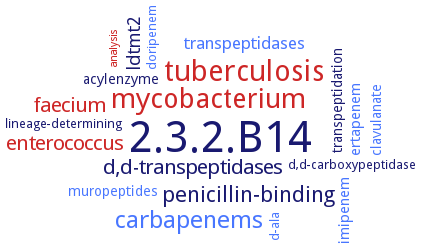2.3.2.B14: L,D-transpeptidase
This is an abbreviated version!
For detailed information about L,D-transpeptidase, go to the full flat file.

Word Map on EC 2.3.2.B14 
-
2.3.2.B14
-
tuberculosis
-
mycobacterium
-
carbapenems
-
penicillin-binding
-
d,d-transpeptidases
-
enterococcus
-
faecium
-
ldtmt2
-
transpeptidases
-
imipenem
-
ertapenem
-
muropeptides
-
acylenzyme
-
clavulanate
-
transpeptidation
-
d-ala
-
lineage-determining
-
doripenem
-
d,d-carboxypeptidase
-
analysis
- 2.3.2.B14
- tuberculosis
- mycobacterium
- carbapenems
-
penicillin-binding
-
d,d-transpeptidases
- enterococcus
- faecium
- ldtmt2
- transpeptidases
- imipenem
- ertapenem
- muropeptides
-
acylenzyme
- clavulanate
-
transpeptidation
- d-ala
-
lineage-determining
- doripenem
- d,d-carboxypeptidase
- analysis
Reaction
Generates 3->3 cross-links in peptidoglycan, catalyzing the cleavage of the mDap(3)-D-Ala4 bond of a tetrapeptide donor stem and the formation of a bond between the carbonyl of mDap3 of the donor stem and the side chain of mDap3 of the acceptor stem. =
Synonyms
CLIBASIA_01175, IprQ, L,D-transpeptidase, L,D-transpeptidase 2, L,D-transpeptidase 5, LdtB, LdtBS, LdtF, Ldtfm, Ldtfm217, Ldtfs, LdtMt1, LdtMt2, LdtP, MAB_1530, MAB_3165c, MT0125, MT0501, MT2594, Rv1433, Rv2518c, transpeptidase, YcbB
ECTree
Advanced search results
Crystallization
Crystallization on EC 2.3.2.B14 - L,D-transpeptidase
Please wait a moment until all data is loaded. This message will disappear when all data is loaded.
structure of YcbB consists of a conserved L,D-transpeptidase catalytic domain decorated with a subdomain on the dynamic substrate capping loop, peptidoglycan-binding and large scaffolding domains. The YcbB-meropenem complex map has ordered density defining the active site residues including the thiol ester covalent link of Cys528 and acylated meropenem
5,5'-dithio-bis-2-nitrobenzoic acid derivative, to 1.55 A resolution. The compound binds to the catalytic cysteine residue, Cys354, in both chains of the asymmetric unit
apo and faropenem-acylated forms of Ldt3 at 1.3 and 1.8 A resolution, respectively. The structures revealed a fold and catalytic diad similar to those of other Ldt enzymes. Docking of beta-lactam antibiotics at the active site suggests interaction with conserved amino acids. Faropenem may be degraded after Cys246 acylation, and possibly only a beta-hydroxybutanoate or an acetyl group covalently attached to the enzyme remains
crystal structures of L,D-transpeptidase 2 complexed with biapenem or tebipenem. Biapenem and tebipenem bind to the outer cavity, covalently inactivate the enzyme, and subsequently degrade via an S-conjugate elimination mechanism
hanging drop vapor diffusion method, using 0.1 M HEPES (pH 7.5), 1 M succinic acid, and 1% (w/v) PEG MME 2000
structure of L,D-transpeptidase 2 in the apo form and in complex with meropenem and imipenem. The periplasmic region of L,D-transpeptidase 2 folds into three domains. The catalytic residues are situated in the C-terminal domain. The acylation reaction occurs between carbapenem antibiotics and the catalytic Cys354 forming a covalent complex. This adduct formation mimics the acylation of L,D-transpeptidase 2 with the donor PG-stem. In the crystal structures of the apo and the carbapenem complexes, the N-terminal domain has a muropeptide unit non-covalently bound to it
structure of Ldt2 (fragment DELTAN41) at 2.98 A resolution and molecular dynamics simulations of complexes with cefdinir, cephalexin, doripenem, and tebipenem
homology modeling and docking of faropenem and meropenem. In the LdtF-meropenem model, both hydrogens of the protonated secondary pyrrolidine nitrogen form a bidentate hydrogen bond with Asp353
-


 results (
results ( results (
results ( top
top





